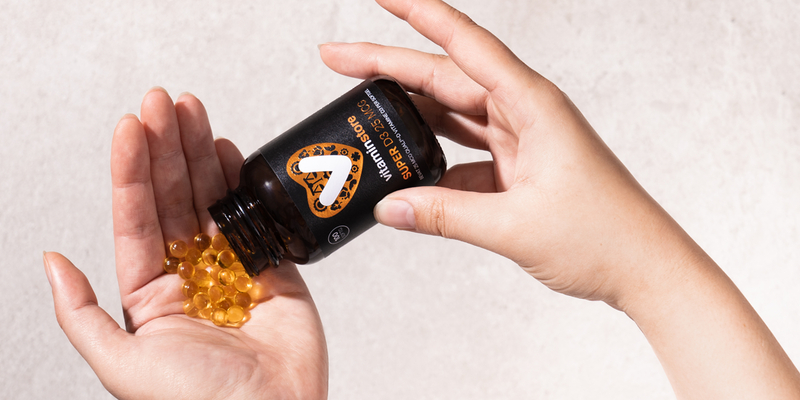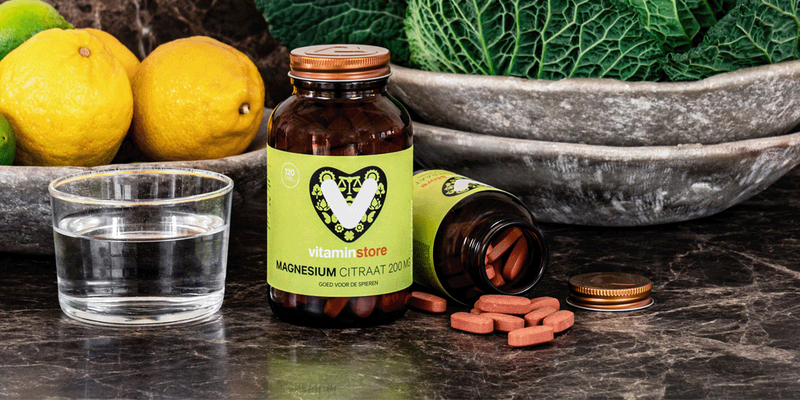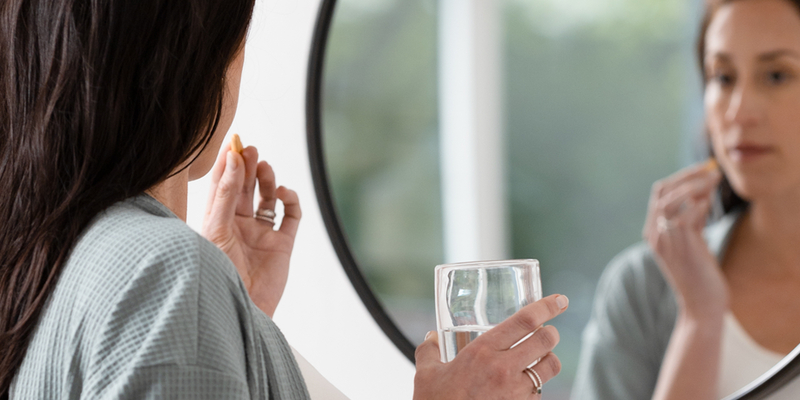Vitamin D Deficiency: Recognising the Symptoms
The sun on your skin, it’s a wonderful feeling, especially after a spell of bad weather. Besides this pleasant sensation, we also need the sun for our vitamin D production. Vitamin D, also known as the 'sunshine vitamin', plays a crucial role in our body. Despite our body's ability to produce this vitamin through sunlight exposure, many people worldwide still face a deficiency. This is partly because we spend a lot of time indoors nowadays, particularly during the winter months.
In this blog, we explain everything about vitamin D. We discuss the benefits of this vitamin, the symptoms of a deficiency, and how to replenish it. We also provide practical tips to ensure you produce enough vitamin D for your body to function properly.
What is Vitamin D Good For?
Vitamin D plays a significant role in your health. The sunshine vitamin aids in the absorption of calcium and phosphorus from food and enhances the uptake of calcium into the bones. Both calcium and phosphorus are vital for maintaining strong bones.
Additionally, vitamin D positively affects the immune system, contributing to good resistance. It is beneficial for muscles, supports normal muscle function, and even helps keep teeth strong.
Did you know that vitamin D receptors are present in many cells and tissues throughout the body? This indicates that this vitamin has a wide range of biological functions.
Read more about the different forms of vitamin D and their absorption.
Do You Need Extra Vitamin D?
Whether you need extra vitamin D depends on various factors. Certain groups, such as infants and the elderly, are more likely to need additional vitamin D. As you age, your skin becomes less efficient at producing vitamin D. Moreover, the kidneys, which convert vitamin D into its active form, may function less effectively. You might also need extra vitamin D if you:
- Follow a vegan or vegetarian diet
- Spend little time outdoors during the day. Your body produces vitamin D when your skin is exposed to sunlight. People who spend a lot of time indoors or live in northern latitudes often do not get enough sunlight.
- Have a darker skin tone
- Wear clothing that covers most of your skin
- Have an unhealthy diet
- Consume a lot of alcohol
- Follow a special low-fat diet
Other Causes of Vitamin D Deficiency
There are various causes of vitamin D deficiency:
- Diet: Although vitamin D is found in some foods, such as oily fish and fortified dairy products, a diet low in these sources can contribute to a deficiency.
- Health Issues: Certain conditions like coeliac disease and Crohn's disease can hinder the absorption of vitamin D from food.
Also, the use of certain medications, such as anti-epileptics and glucocorticoids, can lower vitamin D levels.
Symptoms of Vitamin D Deficiency
As previously mentioned, vitamin D is crucial for many bodily functions. A deficiency can manifest in various ways. Common symptoms of vitamin D deficiency affect our:
- Bones and Joints. You may experience bone pain and an increased risk of fractures.
- Muscles. Weak muscles and muscle cramps can also indicate a vitamin D deficiency. It can even lead to muscle weakness, making everyday tasks more difficult.
- Mood. Low vitamin D levels can affect your mood. Symptoms such as fatigue and mood swings can occur.
- Skin, Hair, and Nails. Dry skin, hair loss, and brittle nails are common symptoms. This is because vitamin D plays a role in cell renewal.
- Immune System. A weakened immune system can indicate a vitamin D deficiency. You are more susceptible to bacteria and viruses.
- Teeth. A vitamin D deficiency can also affect your teeth. You may experience gum problems and a higher risk of cavities. Vitamin D aids in the absorption of calcium and phosphate, which are important for strong teeth.
How Much Vitamin D Do You Need Daily?
The amount of vitamin D you need depends on various factors, including your age, skin colour, and level of sunlight exposure.
Generally, the following daily intake is recommended:
- Babies up to 1 year: 10 micrograms (400 IU). Read more about vitamin D and K for babies.
- Children aged 1 to 18 years: 10 micrograms (400 IU)
- Adults up to 70 years: 10 micrograms (400 IU)
- Adults over 70 years: 20 micrograms (800 IU)
- Pregnant and breastfeeding women: 10 micrograms (400 IU)
It's important to note that the upper limit for safe vitamin D intake is 100 micrograms (4000 IU) per day for adults. Approximately 10-15 minutes of midday sun exposure in the summer can be sufficient for people with lighter skin to produce up to 10,000 IU of vitamin D.
Replenishing Vitamin D Deficiency
Do you have or suspect a vitamin D deficiency? Here are some ways to restore your vitamin D levels:
- Sunlight: Try to get 10-30 minutes of sunlight on your skin daily, depending on your skin type and the sun's strength. Don’t forget to apply sunscreen afterwards to protect your skin from UV damage.
- Diet: Add more vitamin D-rich foods to your diet. Think of oily fish (such as salmon and mackerel), cod liver oil, egg yolks, and fortified foods like milk and cereals.
- Supplements: Consider taking a vitamin D supplement, especially in the winter months or if you spend a lot of time indoors. Consult a doctor or nutritionist for the correct dosage.
Blood tests can help monitor your vitamin D levels and adjust your intake as needed. A healthy lifestyle includes sufficient exercise, a balanced diet, and regular sunlight exposure.
Testing for Vitamin D Deficiency
Do you want to be sure if you need extra vitamin D? You might consider taking a vitamin D test. This will reveal your vitamin D levels. Vitamin D levels in the body are usually measured by the amount of 25-hydroxy vitamin D in the blood. The normal value for vitamin D is 50 nmol/L for men and 35 nmol/L for women. If your value is lower than this, it indicates a deficiency. The ideal value for 25-hydroxy vitamin D is between 50 and 150 nmol/L.
Good to Know
A vitamin D deficiency is common, especially in countries with less sunlight. Do you recognise symptoms of a deficiency, such as fatigue, muscle issues, or mood swings? Consider increasing your vitamin D intake through more sunlight, an adjusted diet, and possibly supplements. Do you want more advice? Our Health Coaches are ready to provide tips and personalised advice.
Sources
- Amrein, K., Scherkl, M., Hoffmann, M., Neuwersch-Sommeregger, S., Köstenberger, M., Tmava Berisha, A., ... & Malle, O. (2020). Vitamin D deficiency 2.0: an update on the current status worldwide. European journal of clinical nutrition, 74(11), 1498-1513.
- Wang, Y., Zhu, J., & DeLuca, H. F. (2012). Where is the vitamin D receptor?. Archives of biochemistry and biophysics, 523(1), 123-133.
- Saraf, R., Morton, S. M., Camargo Jr, C. A., & Grant, C. C. (2016). Global summary of maternal and newborn vitamin D status–a systematic review. Maternal & child nutrition, 12(4), 647-668.
- Annweiler, C., Dursun, E., Féron, F., Gezen‐Ak, D., Kalueff, A. V., Littlejohns, T., ... & Beauchet, O. (2015). ‘Vitamin D and cognition in older adults’: updated international recommendations. Journal of internal medicine, 277(1), 45-57.
- Weikert, C., Trefflich, I., Menzel, J., Obeid, R., Longree, A., Dierkes, J., ... & Abraham, K. (2020). Vitamin and mineral status in a vegan diet. Deutsches Ärzteblatt International, 117(35-36), 575.
- Hanel, A., & Carlberg, C. (2020). Skin colour and vitamin D: An update. Experimental Dermatology, 29(9), 864-875.
- Tardelli, V. S., do Lago, M. P. P., da Silveira, D. X., & Fidalgo, T. M. (2017). Vitamin D and alcohol: A review of the current literature. Psychiatry Research, 248, 83-86.
- Kennel, K. A., Drake, M. T., & Hurley, D. L. (2010, August). Vitamin D deficiency in adults: when to test and how to treat. In mayo clinic proceedings (Vol. 85, No. 8, pp. 752-758). Elsevier.
- Gezondheidsraad. (2012, 26 september). Evaluatie van de voedingsnormen voor vitamine D. https://www.gezondheidsraad.nl/documenten/adviezen/2012/09/26/evaluatie-van-de-voedingsnormen-voor-vitamine-d
- Altieri, B., Cavalier, E., Bhattoa, H. P., Perez-Lopez, F. R., Lopez-Baena, M. T., Perez-Roncero, G. R., ... & Holick, M. F. (2020). Vitamin D testing: advantages and limits of the current assays. European journal of clinical nutrition, 74(2), 231-247.









